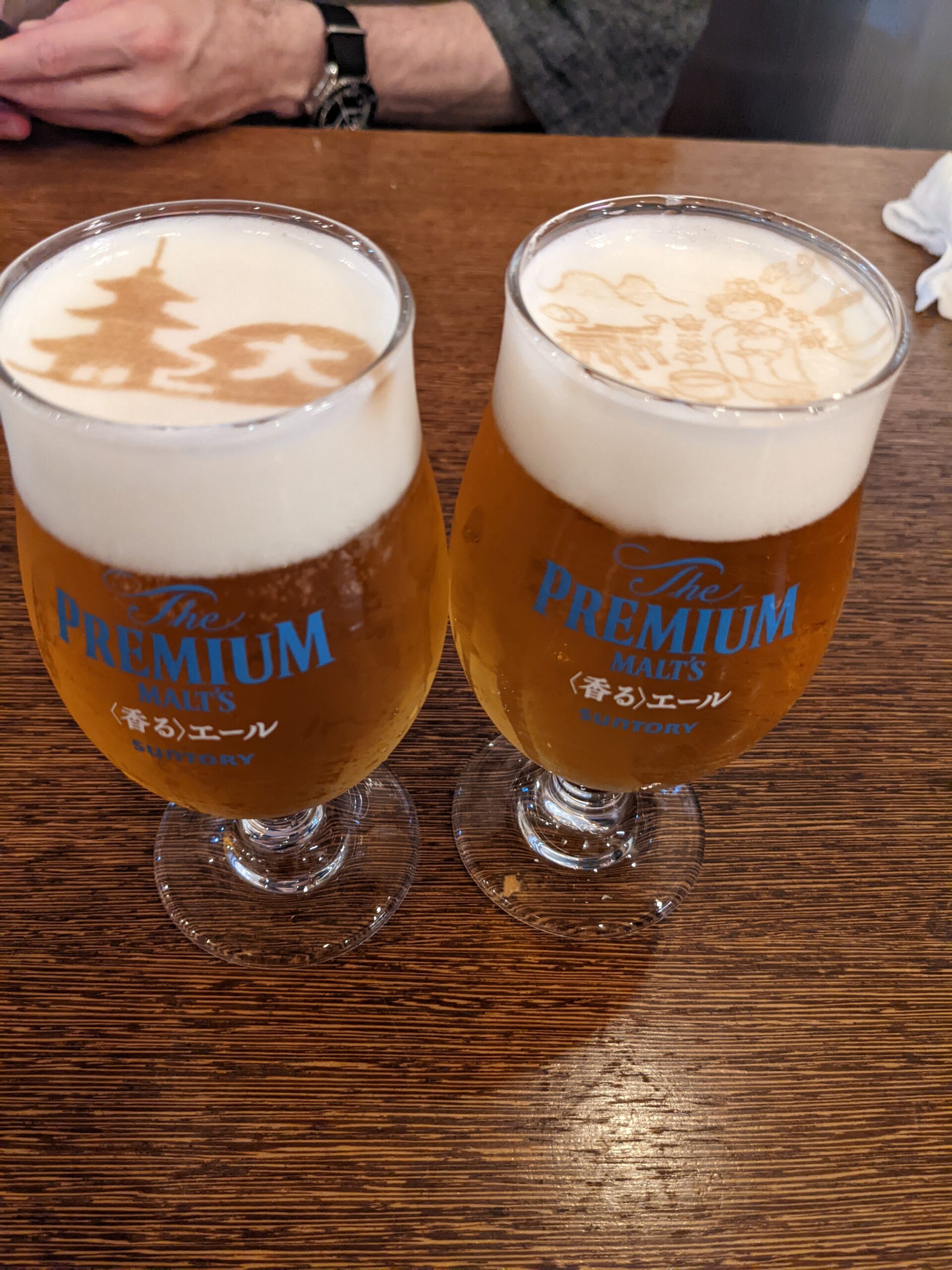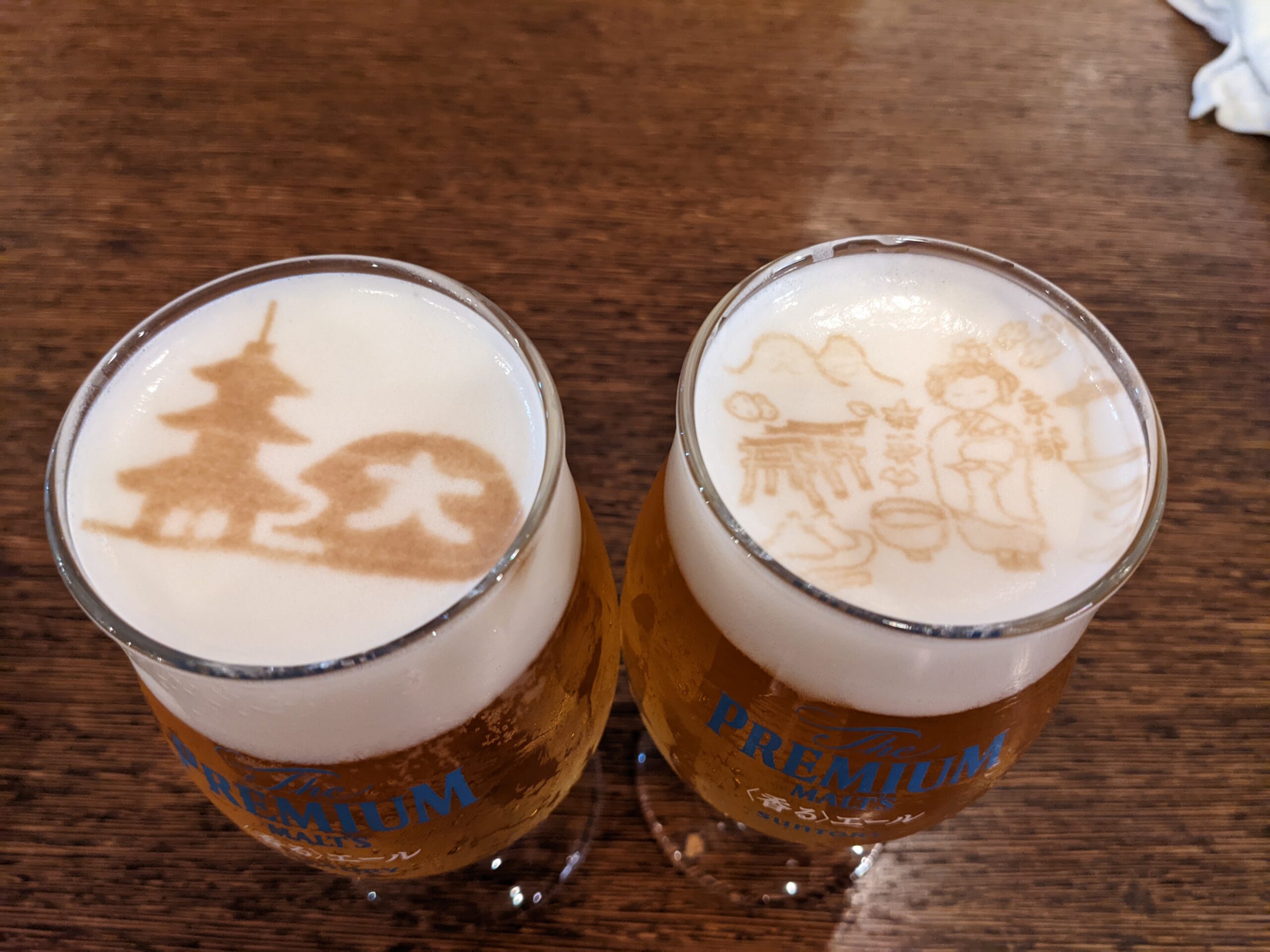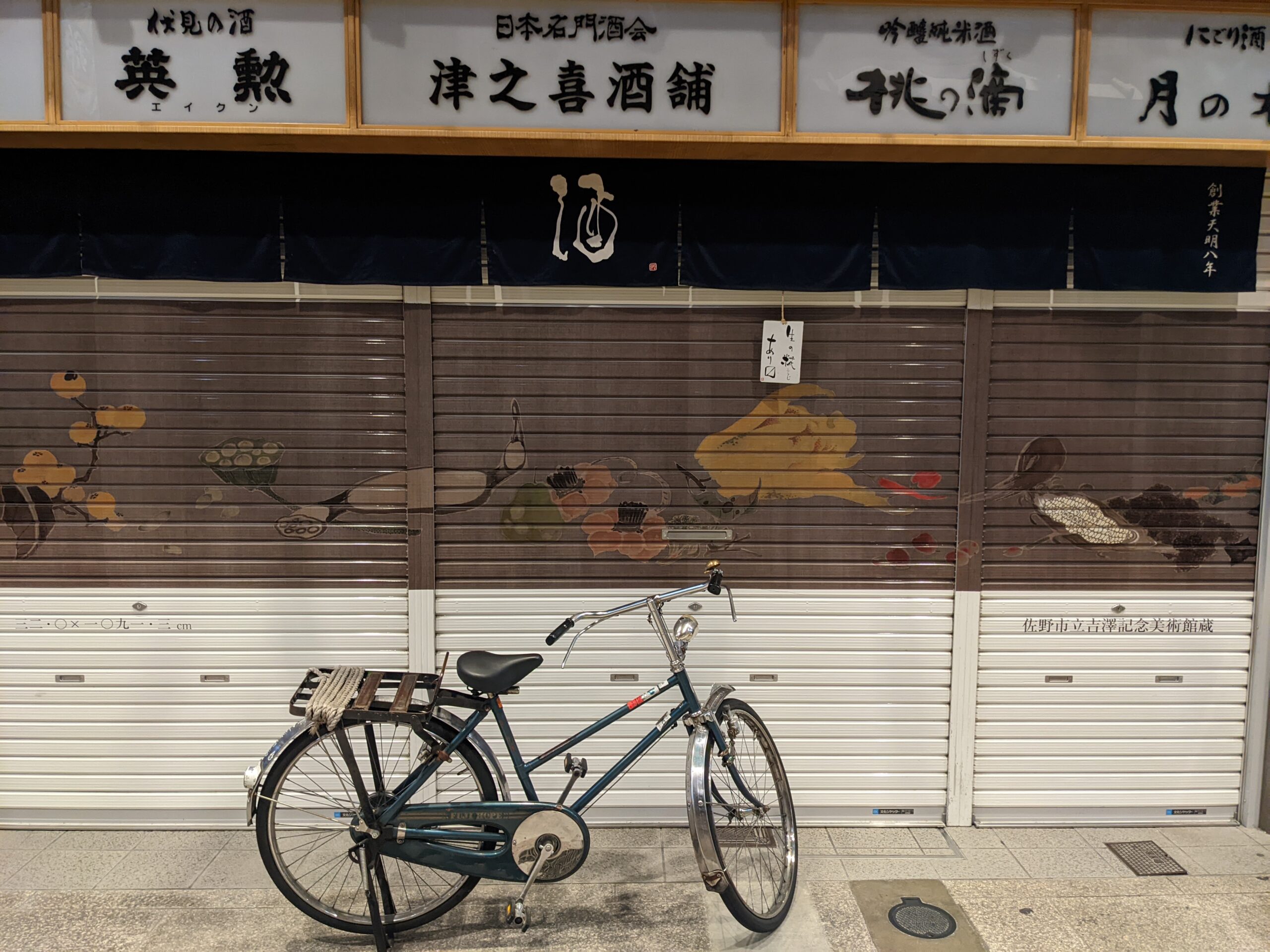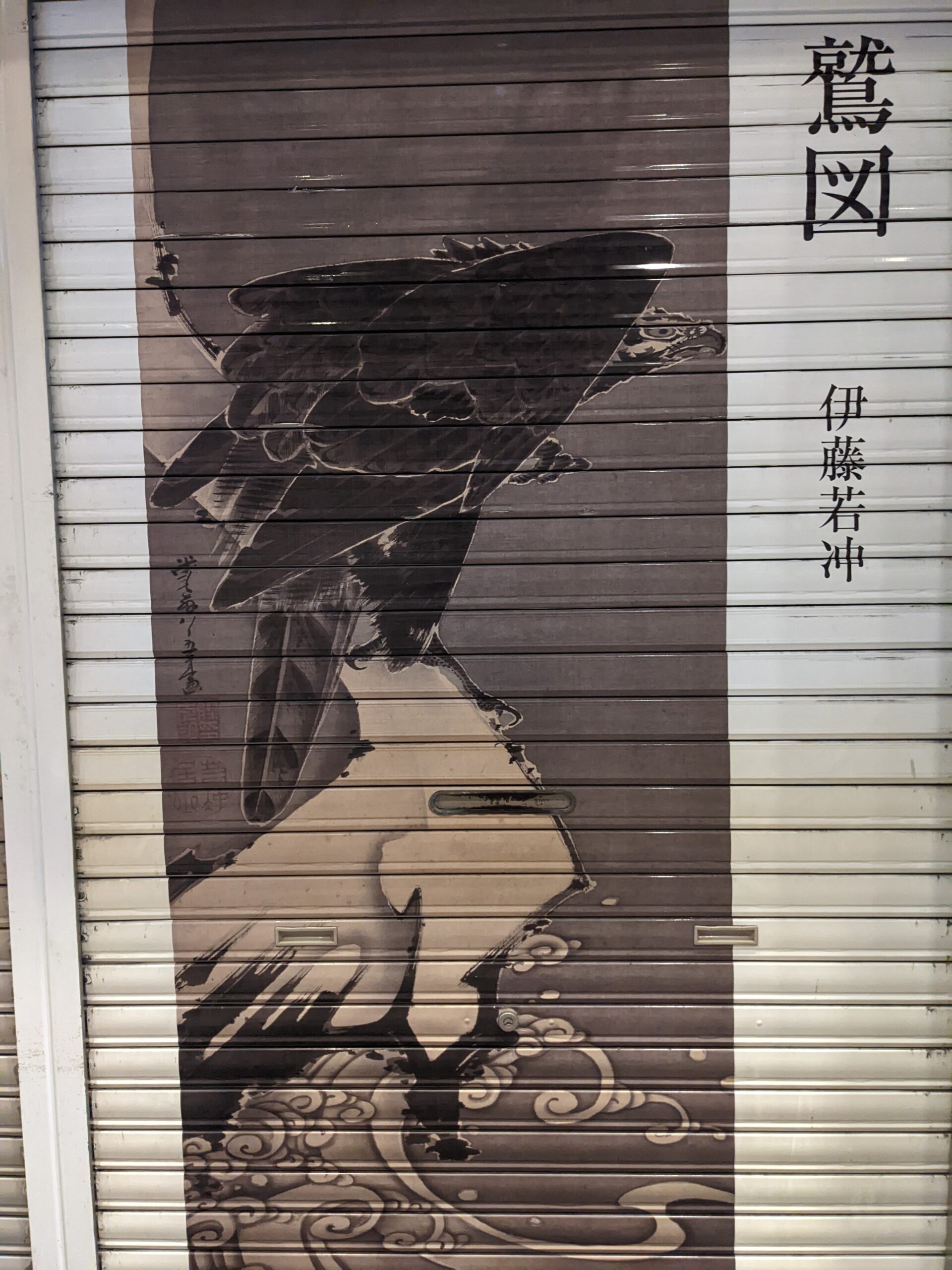Last weekend I went down to Kyoto to hang out with my friend Matt, who I hadn’t seen in five years or so. Zooms don’t count. Matt is currently a professor of Japanese language and culture at a university in Australia, but also is director of a traditional performing arts program held in Kyoto each summer. Each summer save for the last two. The program consists of lessons in noh, kotsozumi drumming, and rakugo, each class taught by a well-respected performer of the field. Kabuki, nihonbuyō (dance) and kyogen are offered in alternate years.
I found a cheap (¥2,000 a night!) business hotel just off of Shijō Dōri a block from Karasuma Dōri and Nishiki Market and headed over to Tokyo Station to catch a shinkansen, carrying just my small backpack with several changes of clothes which I knew I would need as there is no way to prevent me from sweating in the heat. Matt got to the hotel just after I checked in. After sorting through a couple of things it was down to the lobby and out into the streets of Kyoto, heading first over towards the Kamo River, both of us dressed in summer jinbei and Japanese footwear (Matt geta, me seta).
After walking in the heat for a while, checking out places as we walked, we finally decided to go into a little izakaya a block from the river, just north of Shijō Dōri. We were led to a table where we ordered a couple of beers, and water, then looked over the menu. We ate a bit of maguro, some hamo tenpura, yakitori and potato salad, plus the small bowls of macaroni salad we were served when we sat down. And of course, more beer. After thirty minutes or so we had recovered from the heat and were ready for more. So out the door we went.
We walked down to the river bank esplanade where there was some sort of local arts festival going on. The most interesting thing was watching some men rinse newly dyed material for women’s yukata in the river. The pieces of cloth, each perhaps ten meters long, were secured at one end. With the other end drifting down stream with the flow of the river. We arrived towards the end, as the final few pieces were being hauled in and gathered in a bunch, then placed on piles of similar bolts of cloth, each one a different design for a woman’s yukata. The people doing this finished just in time, as a couple of minutes later the river suddenly rose and became a fast flowing muddy, raging river, not the Kamogawa’s usual lazy river.
From there we continued north to see if we could get in at Yamashita, probably my favorite restaurant in Kyoto. I had recently received a summer greeting post card from the restaurant, and I knew that Sunday was the most fun night to dine there. But when we got there the sign on the door informed us they were closed for summer Obon until Wednesday. Oh well. So we bought a couple of bottles of beer and went back down to the river to chat some more.
We proceeded back towards Shijō Dōri, in the area close to Takashimaya department store where we knew there are plenty of places for casual dining. Although it was getting dark, it was still hot, maybe 35 C, and we were in dire need of something to drink, starting with water. We found one place that had some seats open and went in. After a beer and some yakitori, and more water, we moved on, one more street back towards Shijō, where we spotted a place called Jinsuke, meaning something like No Sake, No Life. So we went in and were seated in the front room. There were two older women drinking and eating over deep conversation in the back room, plus another youngish couple at a table by us, and a couple more customers seated at the counter. We started off once more by ordering nama beer and water. When the beer arrived, Suntory Premium Malts, I believe, we were surprised to see pictures in the foam, much like is done with lattes. One was an image of a pagoda, the other of a maiko. It was a first for both of us.


fter that we ordered more, starting with some sake. As for food, there was chicken, hamaguri (clams), satsuma age, and my favorite, yuba maki sushi. The yuba maki was a sheet of yuba with mentaiko spread inside, then rolled and sliced, just like maki-zushi. I want to make it at home, if I can find some mentaiko. We ate more than just that, including some grilled buri and I think some shime sabe.
Two things have been very noticeable the last few times I have been to Kyoto, a lack of tourists, or at least foreign tourists, and the number of yakiniku restaurants. The lack of tourists is due to the pandemic-related restrictions on entering Japan, and I must admit it makes things nice. No more wall to wall crowds of people jamming the narrow streets and alleys. Even Nishiki Market was easy to walk through.
Matt had to work much of Monday so I just wandered around Kyoto with plans to meet him at 9:00 when he wrapped the day’s noh class. After a quick rest in my hotel room to recover from the heat, I headed back out for more exploration, this time wearing sneakers, not seta. I decided to walk through Nishiki Market street towards the river and was pleasantly surprised to see that many of the shops, by now mostly closed, have recently replicated paintings by the Edo period artist Itō Jakuchū on the garage doors that are pulled down at night to secure the shops. I didn’t count, but I would estimate twenty percent of the shops have works by Jakuchū on their fronts. But only at night, which is a bit of a shame.



Itō Jakuchū (1716-1800) was an Edo era painter known today for his very realistic and bright paintings of animals, especially birds. His family owned a grocery shop at the west end of Nishiki (a plaque marks the spot) which meant he lived what would be today a middle-class life, one with enough money to be able to afford the best—and most expensive—painting materials. It’s cool that the merchants of today’s Nishiki Market have honored him in this way.
Around 1:30 I found myself in front of the Minami-za theater and its next-door neighbor, Matsuba Soba. Matsuba, which opened in 1861, is most famous for being where nishin soba was first served (in 1882). I was hungry, but not overly so because of the heat. I hadn’t eaten there in several years, so it was time to go back. So in I went. Coincidentally, the name of my favorite place for nishin soba in Tokyo also begins with Matsu (Matsuya Soba, in Kanda).
I was directed to the elevator with instructions to go up to the third floor. There were two women seated at the next table, and that was it. The waitress brought me a menu and a small cup of cold soba-cha which I quickly downed. L asked for cold nishin soba, something I wasn’t positive they had. She turned pointed to the menu and asked if I wanted it with grated daikon or grated yam. I went with the daikon, and asked for more tea, and then some more. I don’t know why she couldn’t just leave a pitcher of tea or water on the table.

My soba was good. A bowl of cold soba noodles with pieces of nishin (herring) topped with a pile of grated daikon and a cherry blossom shaped piece of pink and white kamaboko, with some wasabi (not freshly grounded) on the side. It was actually a pretty sizeable serving, or maybe I wasn’t too hungry because of heat exhaustion and it just seemed big, and I barely managed to finish it. It tasted good, though, and the cool airconditioned room was much needed. I went down the stairs to the front and paid, then walked a few doors back towards Gion for a macha ice cream cone. Then it was back to my room for a bit of rest.
I found where Matt’s arts program was being held and off we went. Unfortunately, Matt had to teach a class on-line at The University of Sydney at 8:00 the next morning, so we didn’t have much time to carouse this night. We did find a small izakaya that looked good. And there were two empty seats at the counter that was otherwise filled with young women. It was disappointing when we were led to a table upstairs. Oh well. After ninety minutes or so of snacking and sipping we called it a night and wandered off towards our lodgings. It still being early, though, I stopped by Jinsuke for one last bit of sake. They were getting ready to close, but poured one last round of Kyoto sake for me.
Jinsuke
| 京都府京都市下京区綾小路通柳馬場西入ル綾材木町208 |
Sōhonke Nishinsoba Matsuba (総本家にしんそば松葉)
京都府京都市東山区四条大橋東入ル川端町192